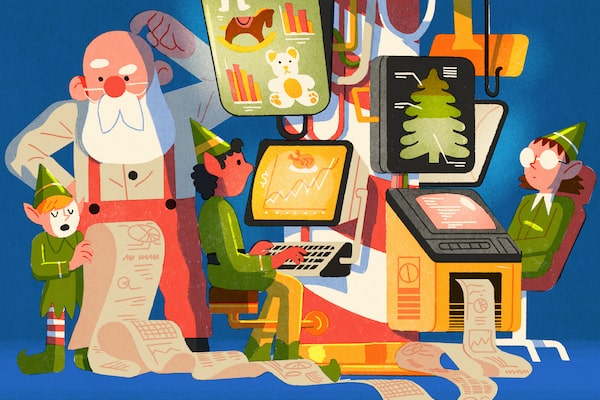
Illustration by Drew Shannon
‘Tis the season to stress over gifts, tangle with decorations and grit one’s teeth through dinners with extended family, otherwise known as contributing to the multibillion-dollar Christmas economy. From the impact of inflation on Christmas dinner to how many Canadian trees get sent to the rest of the world, here are charts that tell the economic tale of Christmas 2023.
Why retailers love the holidays
It’s still too early to know whether the slowdown we’ve seen in the Canadian economy will show up in lower retail sales. When Deloitte Canada surveyed consumers this fall, it found shoppers planned to cut their spending by 11 per cent this year for an average holiday bill of $1,347. Yet after the crucial Black Friday weekend, e-commerce company Shopify said sales by merchants that use its technology grew 19 per cent compared with last year.
This all matters a lot because December is a critical month for retailers. When Statistics Canada reports monthly retail sales, the focus is typically on the seasonally adjusted results, in which regular seasonal swings in shopping patterns are smoothed out so month-to-month trends can be seen. But without the seasonal adjustment, the supercharged December is starkly visible.
That said, December has been slowly losing some of its dominance. This trend has also been seen in the U.S. and has been attributed to the shift to online shopping throughout the year as consumers take advantage of online discount events such as Amazon’s Prime Days during the summer, when other retailers also slash their prices to compete.
A Canadian toy story
When it comes to what might be under the tree, there’s a good chance there’ll be plenty of hockey sticks, baseball mitts and soccer balls. In Canada, outdoor and sports toys was by far the largest category of toy purchased last year, according to retail data firm Circana, which surveys retailers across the country each month.
The outdoor and sports toy segment is shaping up to be the largest again in 2023, Circana’s year-to-date numbers suggest, but toy sales have dropped significantly in several categories. So far this year, only sales of building sets and toy vehicles are ahead of where they were during the same period in 2022.
Canada’s sources for toys
When it comes to where Canada’s toys come from, the Middle Kingdom is still king, despite all the talk about Western economies decoupling from China. Last year China shipped $4.6-billion of toys to Canada, accounting for 61 per cent of all toy imports. The U.S. trailed in second place, with $1.2-billion. The toy export market is changing though. While it’s difficult to tell from the chart, given China’s dominance, the big growth story is Vietnam. Over the past five years, toy imports from Vietnam have tripled, compared with a 27-per-cent increase from China.
Oh Christmas tree exports
The quest to find the perfect Christmas tree has grown more difficult and costly in recent years. Squeezed by higher fertilizer and fuel costs, Christmas tree farmers have hiked their prices, while some have left the business altogether.
That’s showing up in the millions of Christmas trees Canada ships to the world. Last year Canada exported roughly 2.4 million trees, down from 2.8 million in 2019. Although fewer trees were shipped, the value of those Christmas tree exports hit a fresh high of $98-million.
More than 95 per cent of Canada’s Christmas tree exports go to the U.S., but Canadian pine, spruce and fir trees also regularly make their way to Panama, the Cayman Islands and Venezuela, among other warm destinations.
The cost of Christmas dinner
First the good news. Inflation for the items that go into a typical holiday feast is not rising nearly as fast this year as it was last Christmas, and in some cases, it’s falling. The bad news: Christmas dinner inflation, based on a hypothetical basket of food items, was still rising by around 5 per cent annually as of October, more than Canada’s overall inflation rate.
On one big item, Canadians are getting relief: the turkey. The average price per kilogram for a whole fresh turkey in Canada was $5.39 during the four-week period leading up to Nov. 4, according to federal agriculture department data. That was a decrease of 16.6 per cent from the same period in 2022.
The rest of the dinner is where the bite of inflation is still being felt, with prices for fresh vegetables, potatoes, canned fruit, bread and butter all up by between 5 and 10 per cent over last year.